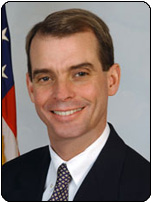Administrator’s Message:
Reducing Substance Use, Reducing Recidivism
 |
Terry
L. Cline, Ph.D. |
When individuals are given a chance
to attain and sustain recovery from
addiction and mental illnesses, the “revolving
door” between incarceration
and community can stop spinning.
SAMHSA’s juvenile justice
and criminal justice programs are
proof of that. One special program,
the Young Offender Reentry Program
(YORP) has helped hundreds of young
people return to their communities
and not end up back in jail or prison.
How does it work? The SAMHSA
News cover story describes the work of
two of our successful YORP grantees.
As an Agency, we continue to create
collaborative relationships with
judges, prosecutors, and public defenders,
as well as treatment providers, researchers,
and public policy decision-makers
who are committed to making sure
young people in the criminal justice
system have a chance.
Our work together is critical. What
we know is that addiction and mental
illnesses are treatable illnesses,
and prevention and treatment are
effective.
When these services are targeted
to juvenile offenders and adult offenders,
the benefits are threefold.
First, if we prevent and treat addiction
and mental illnesses, drug-related
crimes will decrease.
Second, if we intervene early and
get the appropriate treatment services
in place, recidivism rates will drop.
And third, as SAMHSA increases recovery
support services, success
rates for reentry into the community
also increase. In addition, public
safety is enhanced.
We are continuing our efforts to
strengthen partnerships with groups
like the National Association of
Drug Court Professionals, the American
Correctional Association, the Association
of State Correctional Administrators,
the National District Attorneys
Association, the National Governors
Association, and many others.
SAMHSA also continues to build and
collaborate with drug courts and
mental health courts across the country.
Innovative treatment and
support services make a difference
for ex-offenders with mental
and substance use disorders.
The opportunity for partnership,
meaningful change, and building a
healthier Nation has never been stronger.
Our young people deserve a chance
for a life in the community. SAMHSA
is making that a real possibility. 
Terry L. Cline, Ph.D.
Administrator, SAMHSA
See
Also—Helping Young Offenders Return to
Communities
« Part 1: Helping Young Offenders Return to Communities
« Part
2: Helping Young Offenders Return
to Communities
« What Works?
« Grantees List
Next
Article »
Back
to Top
|



